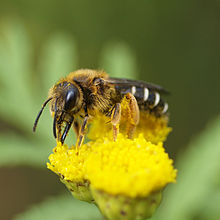| Halictus rubicundus | |
|---|---|

| |
| Female H. rubicundus | |
| Scientific classification | |
| Domain: | Eukaryota |
| Kingdom: | Animalia |
| Phylum: | Arthropoda |
| Class: | Insecta |
| Order: | Hymenoptera |
| Family: | Halictidae |
| Tribe: | Halictini |
| Genus: | Halictus |
| Species: | H. rubicundus
|
| Binomial name | |
| Halictus rubicundus (Christ, 1791)
| |
Halictus rubicundus, the orange-legged furrow bee,[1] is a species of sweat bee found throughout the Northern Hemisphere. H. rubicundus entered North America from the Old World during one of two main invasions of Halictus subgenera. These invasions likely occurred via the Bering land bridge at times of low sea level during the Pleistocene epoch.[2]
The species exhibits different social behaviors depending on climate: it is a solitary species in high elevations or latitudes where the season is short, but eusocial in other areas. Often, solitary and eusocial colonies appear simultaneously in the same population.[3] These sweat bees are extensively studied for their variability in social behavior, which has become a model for social plasticity.[4][5][3][6] This variability has contributed to an understanding of evolution of social behavior.[3][7][6]
- ^ Falk, Steven J. (2015). Field guide to the bees of Great Britain and Ireland. London. ISBN 9781910389027.
{{cite book}}: CS1 maint: location missing publisher (link) - ^ Danforth, Bryan N.; Sauquet, Hervé; Packer, Laurence (1999). "Phylogeny of the bee genus Halictus (Hymenoptera: Halictidae) based on parsimony and likelihood analyses of nuclear EF-1α sequence data". Molecular Phylogenetics and Evolution. 13 (3): 605–618. doi:10.1006/mpev.1999.0670. PMID 10620417.
- ^ a b c Yanega, D. (1993). "Environmental influences on male production and social structure in Halictus rubicundus (Hymenoptera: Halictidae)". Insectes Sociaux. 40 (2): 169–180. doi:10.1007/BF01240705. ISSN 0020-1812. S2CID 44934383.
- ^ Yanega, Douglas (1988). "Social plasticity and early-diapausing females in a primitively social bee". Proceedings of the National Academy of Sciences of the United States of America. 85 (12): 4374–4377. Bibcode:1988PNAS...85.4374Y. doi:10.1073/pnas.85.12.4374. ISSN 0027-8424. PMC 280431. PMID 16593945.
- ^ Yanega, D. (1989). "Caste determination and differential diapause within the first brood of Halictus rubicundus in New York (Hymenoptera: Halictidae)". Behavioral Ecology and Sociobiology. 24 (2): 97–107. doi:10.1007/BF00299641. ISSN 0340-5443. S2CID 11399560.
- ^ a b Soro, Antonella; Paxton, Robert J. (2009). "Characterization of 14 polymorphic microsatellite loci for the facultatively eusocial sweat bee Halictus rubicundus (Hymenoptera, Halictidae) and their variability in related species". Molecular Ecology Resources. 9 (1): 150–152. doi:10.1111/j.1755-0998.2008.02416.x. ISSN 1755-098X. PMID 21564587. S2CID 205969945.
- ^ Yanega, D. (1997) Demography and sociality in halictine bees (Hymenoptera: Halictidae). pp. 293-315 in Choe, J.C. & Crespi, B.J. (eds.) Social Competition and Cooperation in Insects and Arachnids: Vol. II. Evolution of Sociality. Princeton Univ. Press, Princeton.